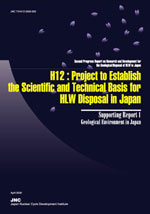Japan Atomic Energy Agency
Geological Isolation Research and Development
H12 report
Supporting Report 1
Geological Environment in Japan
Chapter I : Introduction
1.1 The role of the geological environment in deep disposal
1.2 Geological features of Japan
1.3 Studies of the geological environment
1.3.1 Approaches
1.3.2 Assessments and requirements stipulated by the Government
References
Chapter II : Long-term Stability of the Geological Environment of Japan
2.1 Research on the long-term stability of the geological environment
2.1.1 Natural phenomena relevant to the long-term stability of the geological environment
2.1.2 Predictive evaluation of natural phenomena in the future
2.2 Tectonics of the Japanese islands
2.2.1 Plate movements in the Japanese islands and the adjacent sea areas
2.2.2 Significant change in plate system
2.2.3 Neotectonics
2.3 Earthquakes and fault movement
2.3.1 Fault movement in Japan
2.3.2 Effects of fault movement on the geological environment
2.3.3 Summary
2.4 Volcanism
2.4.1 Characteristics of volcanism in Japan
2.4.2 The effect of volcanism on the geological environment
2.4.3 Summary
2.5 Uplift, subsidence and denudation
2.5.1 Characteristics of uplift, subsidence and denudation in Japan
2.5.2 The effects of uplift, subsidence and denudation on the geological environment
2.5.3 Summary
2.6 Climatic and sea-level changes
2.6.1 Characteristics of climatic and sea-level changes
2.6.2 Effects on the geological environment of climatic and sea-level changes
2.6.3 Summary
References
Chapter III : Characteristics of the Geological Environment of Japan
3.1 Studies on the characteristics of the geological environment
3.1.1 Essential characteristics of a geological disposal environment
3.1.2 Data on characteristics of the geological environment
3.2 Geological structures
3.2.1 Characteristic features of geological structures in Japan
3.2.2 Geological structures and transport pathways
3.2.3 Fracture parameters
3.3 Groundwater flow characteristics
3.3.1 Groundwater flow properties in the deep underground environment of Japan
3.3.2 Investigation and analysis of deep groundwater flow
3.3.3 Summary
3.4 Geochemical characteristics of groundwater
3.4.1 Geochemical characteristics of groundwater in Japan
3.4.2 Case studies on the geochemical characteristics of deep groundwater
3.4.3 Case studies on colloids, organic materials and microbes in deep groundwater
3.4.4 Summary
3.5 Thermal and mechanical properties of the rock mass
3.5.1 Thermal characteristics of the rock mass at depth
3.5.2 Mechanical properties of the rock mass at depth
3.5.3 Excavation disturbance
3.5.4 Summary
3.6 Solute transport in the rock mass
3.6.1 Case studies in the Tono area
3.6.2 Case studies at the Kamaishi mine
3.6.3 Summary
3.7 Natural analogue studies
3.7.1 Examples of natural analogue studies
3.7.2 Summary
References
